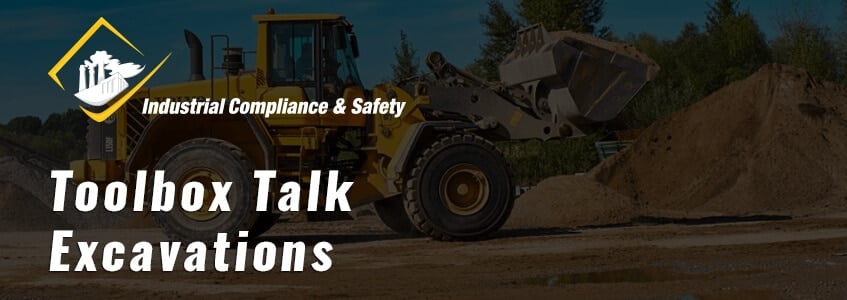Date: ____________________________________
Supervisor: _______________________________
Company Name: _____________________________
Job Name: ______________________________
There are many tasks in the construction industry that require the removal of earth. This process, known as excavation, can be very dangerous. Cave-ins and slough-offs are significant causes of death every year in the field of construction. With this week’s Toolbox Talk, you can review the process of excavation with your employees and make sure that they always follow proper guidelines when performing this kind of work.
Download
Guidelines for Discussion:
Whenever we create an excavation, there are specific rules that we must follow to protect the safety of everyone involved. Excavations can be very dangerous if their sides aren’t properly shored, if they haven’t been checked for hazardous gases, and if they haven’t been thoroughly inspected by a competent person.
Let’s go over the basics of excavation, so that we all know the steps involved in working safety.
Before an excavation:
- Check for underground utilities. Call the companies that operate local utilities, and check with the property owner. If you do not check before digging, you can disrupt a line, which damages the local infrastructure and causes delays.
- Scan the area for potential overhead hazards. Is there a chance of falling rock, soil, or other materials?
- Check the surrounding area and construction site. Make a mental note if there is heavy equipment operating near the excavation area. How deep will your excavation be, and will this be safe with the distance and weight of the heavy equipment?
- Plan for how many people will work inside the excavation.
- Create an escape plan for the workers inside the excavation. Make sure this escape plan will be effective in the event of a cave-in or slide.
- Perform a soil analysis. Compare the soil to your excavation plan - can you perform the type of protective system necessary for the soil type?
While excavating:
- If you create an excavation with a depth of 5 feet or more, you must use a protective system such as shoring or shielding.
- Never store excavated or other materials closer than two feet from the edge of the excavation. The accumulated weight can cause a cave-in.
- Install access ladders at twenty-five foot intervals for all excavations 4 feet or more in depth.
- Meet with all employees who will work in the excavation, and thoroughly review the escape plan.
- Install a guardrail system to protect nearby civilians and employees, especially if there are walkways or bridges crossing over an excavation.
When you are working with an excavation, you must have a competent person onsite to approve the trench protective system and perform daily site inspections. Follow all suggestions and guidance provided by the competent person. Most cave-ins are preventable if an excavation is inspected daily and properly maintained.
Possible causes of cave-ins:
- Failure of protective systems and equipment.
- Hazardous atmosphere.
- Heavy rain or snow.
- Nearby construction or other man-made interference.
Additionally, the competent person must test the atmosphere of excavations 4 feet or deeper. This checks for for potentially hazardous gases and oxygen deficiency. If, while working, an employee suspects the excavation of being oxygen deficient or containing hazardous gas, exit the excavation and call the competent person immediately.
Additional Discussion Notes:
Who is the official competent person within your company? Name him/her.
What tools/materials can your employees use when creating barriers and warning devices around the side of an excavation?
Safety Recommendations: _____________________
Job Specific Topics: ___________________________
Attendees:
____________________________________
____________________________________
____________________________________
____________________________________
____________________________________
____________________________________
____________________________________
____________________________________
____________________________________
____________________________________
____________________________________
____________________________________
____________________________________
____________________________________
____________________________________
____________________________________
____________________________________
____________________________________
____________________________________
____________________________________
____________________________________
____________________________________
Disclaimer
The information contained within this document (both the online and downloadable version) is provided for informational purposes only. Nobody shall take this as a comprehensive or exhaustive resource on this topic. This material is believed to be accurate, however, the information has been compiled from multiple sources, and so Industrial Compliance & Safety assumes no responsibility for the accuracy of this information. We encourage you to consult experts about this specific Toolbox Talk to ensure you are compliant with any and all safety regulations and processes. In no event does the content of this document supersede any applicable local, state, or federal statutes or regulations.





